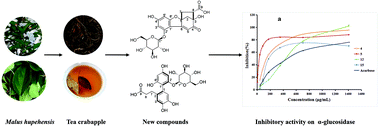Dihydrochalcone-derived polyphenols from tea crab apple (Malus hupehensis) and their inhibitory effects on α-glucosidase in vitro
Abstract
Three dihydrochalcone-derived polyphenols, huperolides A–C (1–3), along with thirteen known compounds (4–16) were isolated from the leaves of Malus hupehensis, the well-known tea crab apple in China. Their chemical structures were elucidated by extensive spectroscopic analysis including NMR (HSQC, HMBC, 1H–1H COSY and ROESY), HRMS and CD spectra. Huperolide A is a polyphenol with a new type of carbon skeleton, while huperolides B and C are a couple of atropisomers, which were isolated from natural sources for the first time. The antihyperglycemic effects of the isolated compounds were evaluated based on assaying their inhibitory activities against α-glucosidase. As a result, phlorizin (4), 3-hydroxyphloridzin (5), 3-O-coumaroylquinic acid (12) and β-hydroxypropiovanillone (15) showed significant concentration-dependent inhibitory effects on α-glucosidase. Therefore, those compounds might be responsible for the antihyperglycemic effect of this herb, and are the most promising compounds to lead discovery of drugs against diabetes.



 Please wait while we load your content...
Please wait while we load your content...